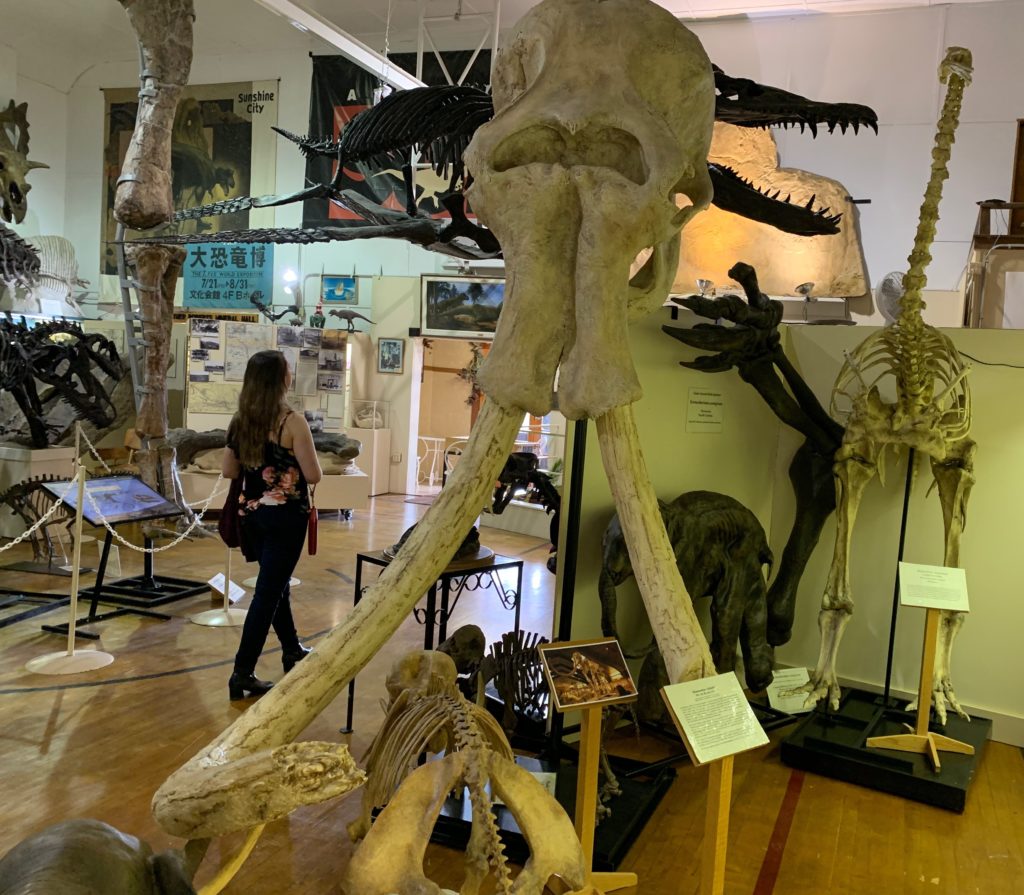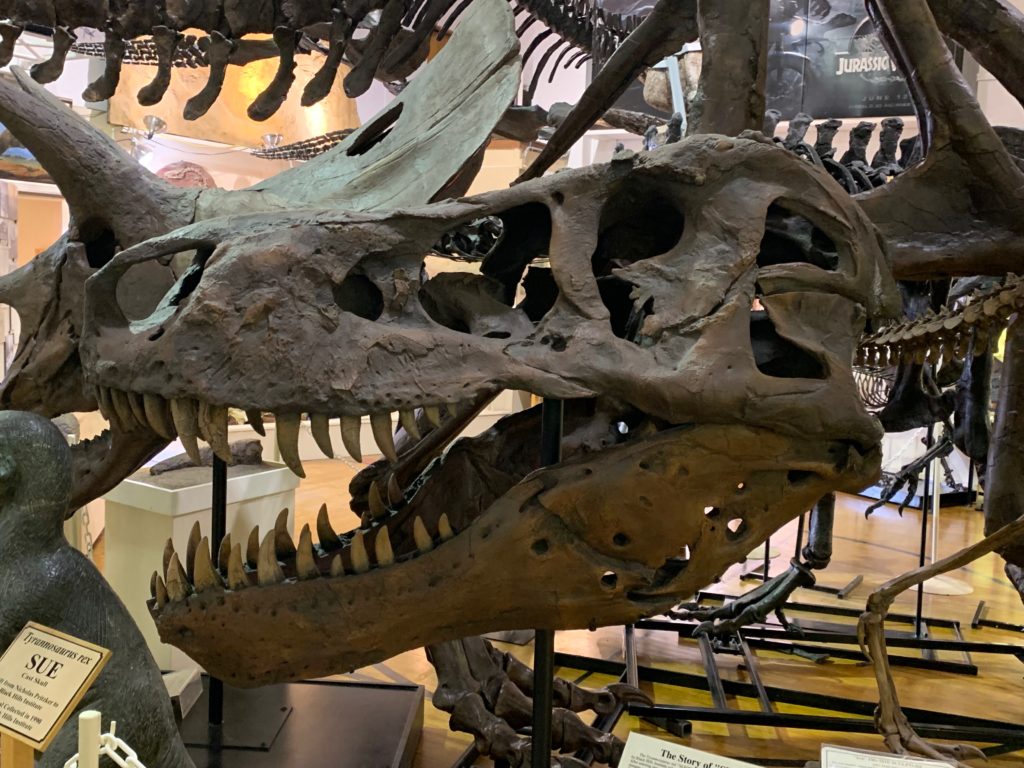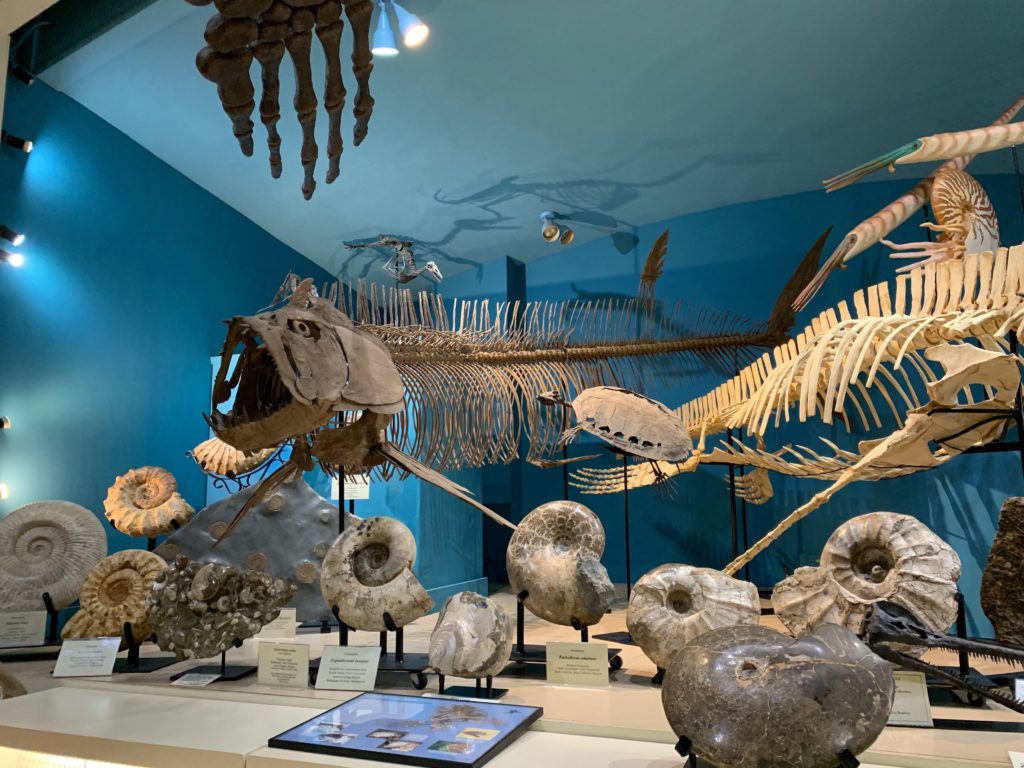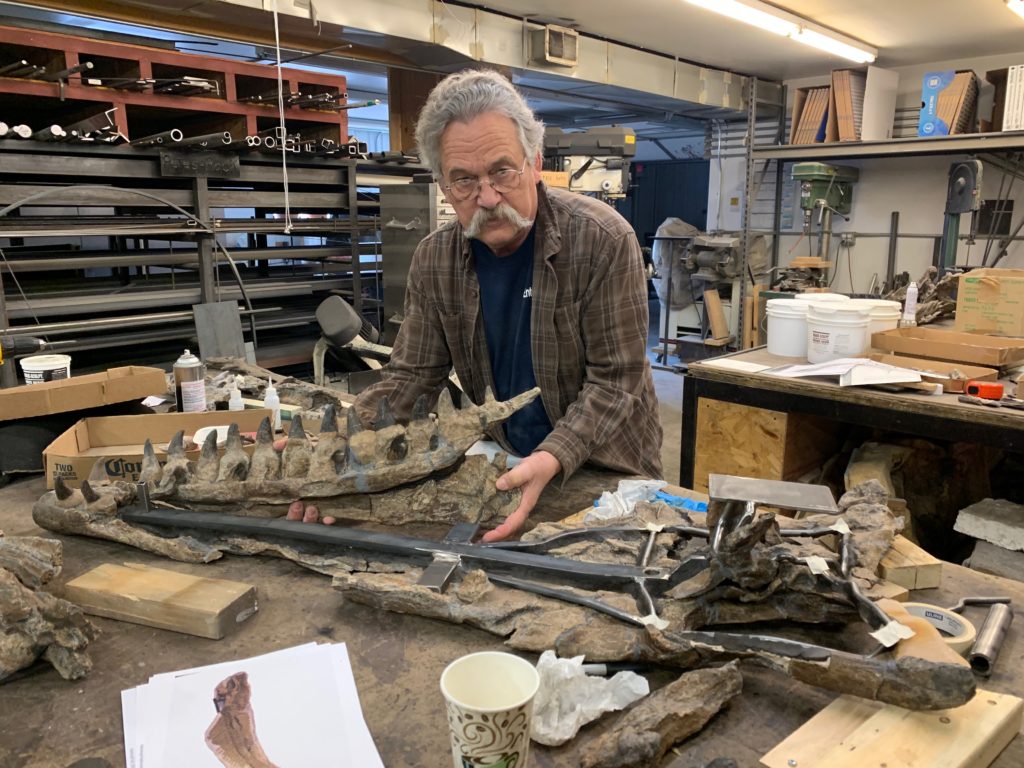
The Black Hills Institute of Geological Research Museum in Hill City, South Dakota, has numerous dinosaur skeletons and fossils that can be viewed by museum-goers.
Black Hills Institute Provides Answers
In my native South Dakota, nestled on the main street of Hill City (population 1,008) in an old city auditorium, is a different kind of business/museum.
The Black Hills Institute (BHI) of Geological Research and museum has displays of dinosaur skeletons, some flying overhead, some ready to take a step.
All are close enough for a visitor to almost reach out and touch. Having spent time in the New York Natural History Museum and its wide-open spaces with skeletons set far back in displays, I was excited to be in such an intimate space, so close to prehistoric bones.
 Looking at the numerous glass-lit shelves that house cycads and ammonites, I spotted a golden statue that seemed modern and out of place: it was an Emmy.
Looking at the numerous glass-lit shelves that house cycads and ammonites, I spotted a golden statue that seemed modern and out of place: it was an Emmy.
Circling the News spoke to Peter Larson, founder of BHI, who explained that Todd Miller had made a documentary “Dinosaur 13,” which won the 2015 Emmy for Outstanding Science and Technology Programming at the 36th Annual News and Documentary Emmy Awards. (Editor’s note: Miller’s “Apollo 11” premiered at the 2019 Sundance Film Festival, where it was a Grand Jury Prize nominee.)
Larson, who attended the awards show, said “It was pretty awesome, very surreal and a wonderful surprise, and Todd’s work deserved that.”
The film was about Larson’s and the institute’s discovery of “Sue,” the largest and most complete Tyrannosaurus rex skeleton ever discovered, and the legal battle that followed that discovery.

A cast of the T-Rex Sue can be seen at the museum.
Sue was a unique find because about 90 percent of her bones were uncovered at her burial location, near Faith, S.D.
The National Parks Service, the Bureau of Indian Affairs and landowner Maurice Williams all claimed ownership of the skeleton that would eventually be sold to the Field Museum in the National History of Chicago for $8.3 million.
The F.B.I. raided the BHI and took the skeleton. A lengthy court case resulted in Larson serving two years for a “charge” that had nothing to do with Sue.
The T-rex skeleton was given back to the landowner, Williams, who had accepted a $5,000 check from BHI and claimed the money paid to him was to allow Larson (and the BHI) to clean and unearth the fossil.
“It was just so unbelievable that someone would come out and say something that wasn’t true,” said Larson, who could be bitter—but is not. When I visited him in March, he was excited about a new find and the resulting article.
He had just finished collaborating on “A seismically induced onshore surge deposit at the KPg boundary, North Dakota” with 10 noted international and U.S. geologists/professors. The paper was published in the Proceedings of the National Academy of Sciences.
Although scientists have speculated that the asteroid Chicxulub was the cause of the dinosaurs’ demise about 66,000 million years ago, a time known as KPg–the Cretaceous-Paleogene boundary–the time when the dinosaurs died and the beginning of the birth of mammals.
There is disagreement in the scientific community about the exact events that led to the extinction and not a lot of scientific evidence to support how—was it an atmospheric and climate change? Was it immediate or did it happen over time?

Prehistoric fish had been discovered in Hell Creek Formation in North Dakota at the Tanis Site. They were densely packed in the ground in that area and had little pebbles of “natural glass” in the gill area that perhaps was sucked up from the water.
Why is this important?
The asteroid, which was believed to have been 6.2 to 9.3 miles in diameter and 12 miles in depth, slammed into the Caribbean Sea and the edge of the Yucatan Peninsula. On impact, the soil, anhydrite or gypsum, would have ejected sulfur trioxide combined with water to produce a sulfuric acid, similar to acid rain, that blocked sunlight from reaching the earth.
Some experts have estimated that the force of the impact was 100 million megatons of TNT. Not only did the blast cause tsunamis, it triggered massive seismic waves. Scientists estimate that resulting earthquakes were a magnitude 10 or 11.
Tektites (glass beads formed in the atmosphere from rock melted by the impact) would have rained down 45 minutes to an hour after impact.
Scientists speculate that there was an inland waterway that ran from the Gulf of Mexico up to North Dakota.
Although tsunamis would most likely have hit North and South America as they then existed, scientists don’t think it was a tsunami that caused this mass/stack of freshwater fish, vertebrates, burned tree trunks, conifer branches, insects, marine ammonites and other marine creatures to be found at Tanis.
More likely it was a seismically-coupled seiche that occurred after Chicxulub hit Earth. (A seiche is a large, rogue wave, like sloshing water in a bathtub or a lake. For example, Lake Michigan rose 10 ft. and then 150 ft. past the normal line in 1956.)
Scientists are excited because Tanis is one of the few areas found that provides evidence of what occurred almost immediately after the asteroid hit.
Or as the recent article stated, “The Tanis site, which preserves a rapidly deposited, ejecta-bearing bed in the Hell Creek Formation, helps to resolve that long-standing deficit. Emplaced immediately (minutes to hours) after impact, Tanis provides a post-impact “snapshot,” including ejecta accretion and faunal mass death, advancing our understanding of the immediate effects of the Chicxulub impact.”
This discovery helps scientists with evidence surrounding the global event that precipitated the dinosaurs’ demise.
Larson said, “This discovery is the one of the most important KPg boundary sites in the world, second only to the original site in Italy where Louis and Walter Alvarez found the first evidence of the giant asteroid that killed the dinosaurs and wiped out 80 percent of all life on this planet.”
The BHI has prepared and mounted dinosaur displays for the Smithsonian Institute, and museums in Alberta, Japan, Spain, Italy, Germany, Switzerland, Australia and Peru.
Questions about dinosaurs or fossils, replicas or casts? Visit: bhigr.com.

Black Hills Institute founder Peter Larson shows how bones are prepared to be mounted.
(Editor’s note: Make plans to visit Hill City and the dinosaur shop, take in Mt. Rushmore and Crazy Horse monuments, but unless you’re a motorcyclist, steer clear of the Black Hills during the Sturgis Motorcycle Rally.)

Thank you for the pictures and article on dinosaurs and the Sue discovery.
Very interesting.
Sue, my Mother (RIP) was born not to far from Hill City in Redfield. Small world!
I always find the articles you write about “home “ very interesting!
Maybe because I have been to these places but you share stories that I and a lot of other people don’t know about. Thanks Sue.